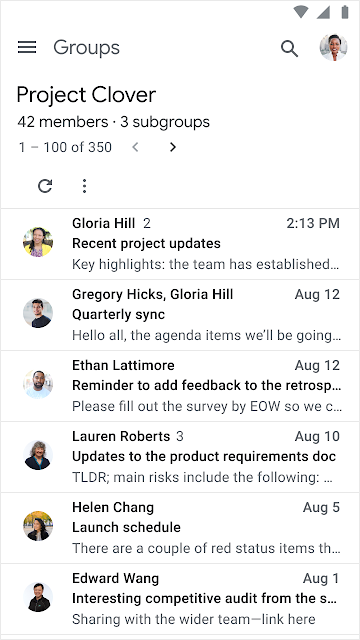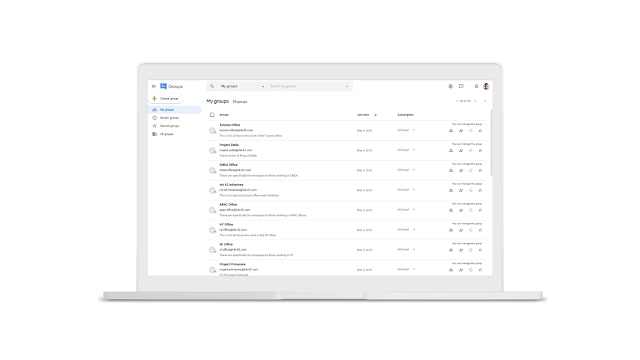What’s changing
We’re making the
new Google Groups generally available - featuring an updated interface and more streamlined controls that make it easier to create, manage, and use. The modern interface is similar to other G Suite apps, such as Gmail, and makes Groups more efficient for new and existing users. It was previously
available in beta.
We’ll introduce new Groups according to this timeline:
- May 26, 2020: Setting to turn new Groups on or off will begin to appear in the Admin console. This setting will be on by default. If turned off, users will not be able to access the new interface. If left on, users will be migrated to the new interface on the dates below.
- June 9, 2020: Users in Rapid Release domains will start seeing new Groups, unless their admin has turned it off. Individual users will have the option to revert to classic Groups.
- June 23, 2020: Users in Scheduled Release domains will start seeing new Groups, unless their admin has turned it off. Individual users will have the option to revert to classic Groups.
See more details on these stages and changes below.
Who’s impacted
Admins and end users
Why you’d use it
New Groups has a more efficient, streamlined UI, which makes it easier for users to create and manage groups. It includes the most used features from the classic interface, along with:
- Read group conversations and write messages
- Consolidated settings for improved navigation
- Quick, simplified group creation
- New filtering and search options to help you find content quickly
- Improved group member management and more
Use our Help Center to
learn more about the improvements in new Groups.
Additional details
Features not available in the new Groups UI Most commonly used features are available in new Groups, and the new interface will improve the experience of using Groups for most users. However, not all features from classic Groups are currently available, including collaborative inboxes, tags, and categories. Use the Help Center to see
which features aren’t available in the new interface. We’re working to add many of these features to new Groups, but organizations and users that rely on these features should continue to use classic Groups for the moment.
We’ll announce when features are added to new Groups on the
G Suite Updates blog.
The new Admin console setting to turn new Groups on or off
If you leave new Groups turned ON in the Admin console Starting on June 9, we’ll begin redirecting users in Rapid Release domains to the new interface when they visit groups.google.com. On June 23, users in Scheduled release domains will begin seeing the new experience.
Individual users will have the option to revert to the classic UI by going to Settings > Return to classic Google Groups. If they opt-out, they will see the classic interface when they visit Groups next. Users can switch between classic and new Groups as many times as they like.
If you turn new Groups OFF in the Admin console If you turn new Groups OFF in the Admin console, your users will not be able to access the new UI and will see the classic interface whenever they go to Google Groups. Note that users who have new Groups turned off by their admin will also not be able to access any new Groups URL, even if they’re sent a direct link by another user that is using the new interface.
If your organization participated in the beta Organizations participating in the alpha or beta will start to see the setting to turn new Groups on or off in the Admin console starting on May 26. If an alpha or beta Admin uses the Admin console setting to turn off new Groups, that will take effect within 24 hours. All users currently using new Groups through the beta would be reverted back to classic Groups.
End users at organizations that are part of the alpha or beta program and who are currently using the new interface will continue to see the new user interface throughout, unless their admin turns off new Groups at a domain level.
End users at organizations that are part of the alpha or beta program who have previously reverted to classic Groups will continue to see the old interface, and will have the option to use new Groups if they want.
Getting started
- Admins: The new interface will be ON by default and can be disabled at the domain level by going to Admin Console > Apps > G Suite > Groups for Business > New groups. Visit the Help Center to learn more about managing new Google Groups for your organization.
- End users: The new interface will be ON by default and can be disabled or enabled by the user on each browser.
Rollout pace
Admin console setting End user rollout: Availability
- Available to all G Suite customers.
Resources








